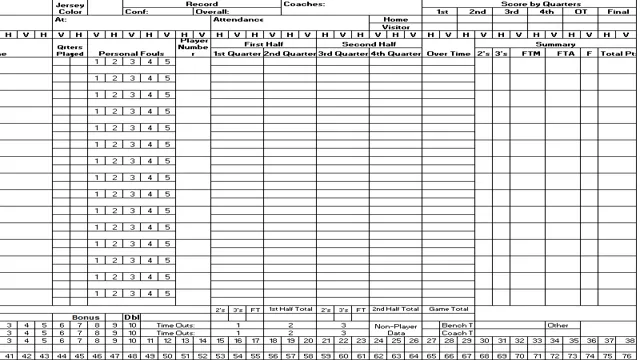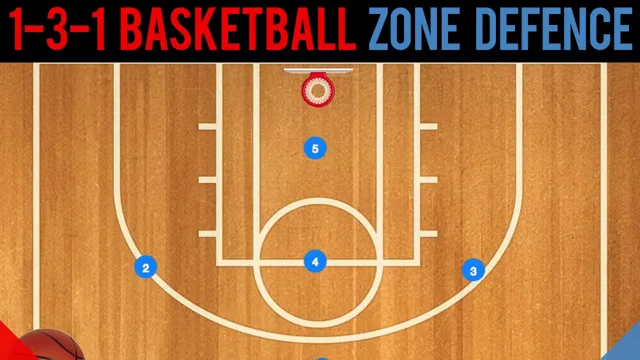Do you love basketball and want to know more about basketball scoresheets? Well, you’re in the right place! Welcome to “The Ultimate Basketball Scoresheet Guide”, the ultimate resource for any basketball enthusiast who wants to master the art of keeping score while watching a game. Keeping score is not only important for coaches, but for players, fans, scouts, and statisticians as well. The score sheet is a vital document that captures every second of the game, from the players’ names and jersey numbers to the scores, fouls, and timeouts.
However, if you’re new to basketball or haven’t kept score before, it can be overwhelming to know where to start. This guide will provide you with a step-by-step breakdown of how to keep score, including the different types of scoresheets, common terminology, and the specific symbols to use for each type of action. We’ll also share tips and tricks to help you stay organized and focused during the game.
The goal of this guide is to make you feel confident in your ability to keep score accurately and efficiently, so you can fully enjoy the game without any added stress. Whether you’re a seasoned pro or a complete newbie, “The Ultimate Basketball Scoresheet Guide” has something for everyone. So, let’s get started!
Basics of a Basketball Scoresheet
A basketball scoresheet is a record-keeping tool that allows for precise and timely documentation of each game’s events. It requires systematic notations, symbols, and abbreviations to indicate game progress, player performance, and other relevant information. While there is no universal format, most scoresheets generally have columns for player numbers, field goals, free throws, rebounds, assists, turnovers, and fouls.
The scoresheet also highlights the quarter or period, the current score of the game, and the cumulative team fouls. The referee, the team’s head coach, and official scorekeeper are usually the ones who fill out the scoresheet. Accurate and up to date scoresheets play a crucial role in the game’s integrity, ensuring transparency and fairness in keeping track of scores, comparing players, and evaluating team performance.
Understanding the Layout and Sections
When it comes to basketball scoresheets, it’s important to understand the basic layout and sections. Typically, a basketball scoresheet will include spaces for listing the names of both teams, the date and location of the game, and the names of the officials. The score section will have columns for recording the points scored by each player and team throughout the game.
Additionally, there are spaces for recording fouls and time-outs taken by each team, as well as tracking player substitutions. Understanding how to properly fill out a basketball scoresheet is crucial for accurate record-keeping and analyzing gameplay. So, if you want to be an efficient scorer, make sure you are familiar with all of the necessary sections and elements on a basketball scoresheet.
Important Statistics and Data to Track
As a basketball coach or statistician, keeping track of key data during games is essential not only for measuring individual player performance but also for overall team analysis. One of the primary tools for tracking this data is the basketball scoresheet. A standard scoresheet consists of two sections, one for individual player statistics and one for team statistics.
The individual player section tracks a player’s points, rebounds, assists, steals, blocks, and personal fouls. The team section tracks total points, rebounds, assists, turnovers, and field goal percentage, among other statistics. By monitoring these statistics over time, coaches can identify areas for improvement and develop more effective game strategies.
A well-kept basketball scoresheet is indispensable for success on the court.
Creating a Scoresheet for Your Game
If you’re the coach of a basketball team, keeping track of the scores and statistics of players is crucial for assessing strengths and weaknesses. That’s why having a well-designed basketball scoresheet can come in handy before, during, and after the game. To create your own scoresheet, start by listing all the important information you want to track.
This can include players’ names, positions, and minutes played, as well as shot attempts, rebounds, and fouls. Determine the size and layout of the scoresheet based on how much information you’ll be tracking and how many games you’ll be using it for. You can either create your own from scratch or use templates available online.
Once you’ve designed your scoresheet, print out enough copies for each game, and you’re all set to keep track of the game’s progress and player performance! With a well-planned basketball scoresheet, you’ll be able to analyze the data and make thoughtful decisions to improve the team’s performance in future games.
Tools and Materials Needed
When creating a game, it’s important to have a scoresheet so players can keep track of their progress and compete with one another. To create a scoresheet, you will need some basic tools and materials. First, you will need a pen or pencil for writing, preferably one with a comfortable grip.
You will also need paper, or a notebook if you want to keep all of your scoresheets in one place. Depending on the game, you may need a ruler to create neat lines for the scoresheet, and a calculator to tally up the scores. To make the scoresheet more visually appealing, you might want to use colored pencils or markers.
With these tools and materials, you can create a scoresheet that is easy to use and looks great. Just remember to keep it simple and straightforward, and to test it out with a few players to make sure it’s easy to understand.
Step-by-Step Guide to Building Your Scoresheet
Creating a custom scoresheet for your game can seem intimidating, but it can actually be a fun and rewarding process. To start, you’ll need to decide what information you want to track during your game. This could include points, fouls, timeouts, or any other important stats.
Once you have your list, you can begin designing your scoresheet. There are many templates available online, or you can make your own from scratch using a program like Excel or Google Sheets. Be sure to include plenty of space for each stat, and consider adding a section for notes or other important information.
When it comes to the design, don’t be afraid to get creative! You can add graphics, color-coding, and other visual elements to make your scoresheet both informative and visually appealing. With a little bit of time and effort, you can create a scoresheet that is perfectly tailored to your game and will help you keep track of all the action. So why not give it a try? You might be surprised at how much fun it can be!
How to Use Your Scoresheet During the Game
When it comes to the game of basketball, keeping track of the score is essential. That’s where the basketball scoresheet comes in. During the game, the scoresheet can be a valuable tool for coaches, players and fans alike.
It allows them to track the score and statistics of each player in real-time. However, simply having a scoresheet is not enough. It’s important to know how to use it effectively.
One key tip is to stay organized. Make sure the scoresheet is labeled correctly and use clear handwriting. Another valuable technique is to color-code information.
This can make it easier to quickly identify important stats. Additionally, it’s important to update the sheet regularly. This ensures that the information is accurate and can help make more informed decisions during the game.
Thus, utilizing your basketball scoresheet in a clear and organized way can be game-changing for coaches and players alike.
Tips and Strategies for Efficient Scoring
Using your scoresheet during the game can be a game-changer for efficient scoring. It’s crucial to keep your eye on the scoresheet, and to ensure that all the important information is being recorded correctly. The key is to use shorthand that makes sense to you.
It’s best to break down the scoresheet into three sections, which include player statistics, game events, and miscellaneous notes. Player statistics include points, rebounds, and assists; game events include fouls, timeouts, and half-time scores; and miscellaneous notes can include any other information you feel is important to record. During the game, it’s important to be quick and accurate while recording the information.
By doing so, you’ll be able to keep up with the game, keep track of how well players are doing, and make better decisions for the team. By following these tips and strategies, you can use your scoresheet effectively and optimize your scoring efficiency.
Using the Data to Analyze and Improve
“Scoresheet analysis” Using your scoresheet during a game can provide valuable insights and help improve your team’s performance. First, take a look at the individual scores of each player and compare them to their performance in prior games. This can help you identify consistent strengths and weaknesses, which can be useful in developing new strategies.
Next, consider the team’s overall performance and look for areas where improvements can be made. Are there specific plays or tactics that consistently lead to success? Are there particular areas where the team tends to struggle? Finally, use the data to make adjustments in real-time, such as swapping out players or adjusting strategies. By using your scoresheet as a tool for analysis and improvement, you can gain a competitive edge and help your team achieve their goals.
Conclusion: Get Started on Your Basketball Scoresheet Today
Just like a basketball scoresheet, life is full of highs and lows, wins and losses. It’s up to us to keep track of the game and adjust our strategy accordingly. And just like in basketball, teamwork and communication are key to achieving our goals.
So let’s keep playing, keep scoring, and most importantly, keep having fun.”
FAQs
What is a basketball scoresheet used for?
A basketball scoresheet is used to record and keep track of the different events and points scored by individual players and teams during a basketball game.
What are the common elements of a basketball scoresheet?
The common elements of a basketball scoresheet include player and team names, scoring details, fouls, timeouts, and quarter/half time scores.
Who typically fills out a basketball scoresheet?
A basketball scoresheet is usually filled out by the official scorer or a designated person who has knowledge of the sport and its scoring rules.
What is the importance of accuracy in filling out a basketball scoresheet?
Accuracy in filling out a basketball scoresheet is crucial as it is used for official record-keeping, score analysis, and player/team performance evaluation.
Can a basketball scoresheet be modified or altered after the game is over?
Ideally, a basketball scoresheet should not be modified or altered after the game is over as it could affect the validity of the recorded scores and data. However, corrections can be made if there are mistakes or discrepancies that need to be rectified.


